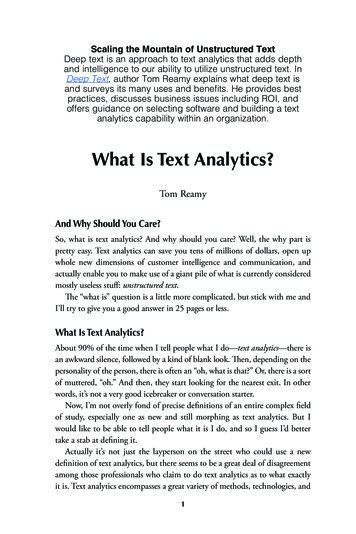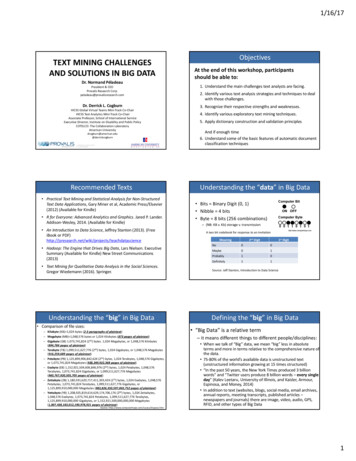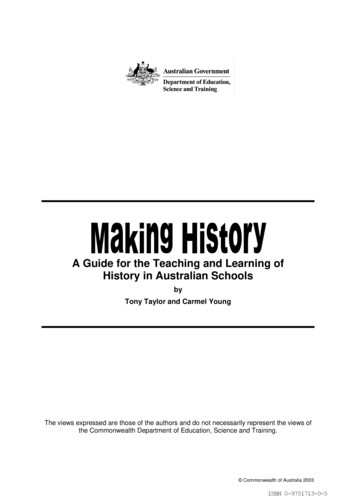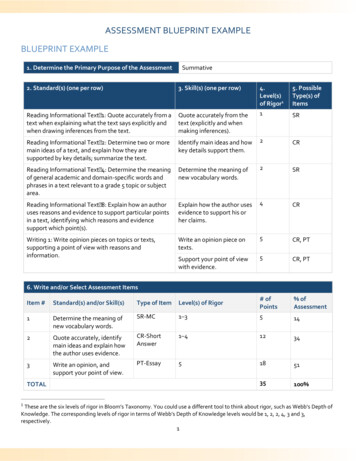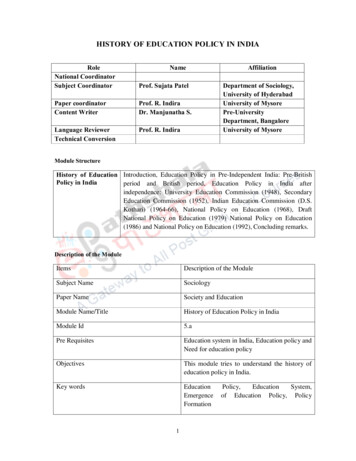
Transcription
HISTORY OF EDUCATION POLICY IN INDIARoleNational CoordinatorSubject CoordinatorNameProf. Sujata PatelPaper coordinatorContent WriterProf. R. IndiraDr. Manjunatha S.Language ReviewerTechnical ConversionProf. R. IndiraAffiliationDepartment of Sociology,University of HyderabadUniversity of MysorePre-UniversityDepartment, BangaloreUniversity of MysoreModule StructureHistory of Education Introduction, Education Policy in Pre-Independent India: Pre-BritishPolicy in Indiaperiod and British period, Education Policy in India afterindependence: University Education Commission (1948), SecondaryEducation Commission (1952), Indian Education Commission (D.S.Kothari) (1964-66), National Policy on Education (1968), DraftNational Policy on Education (1979) National Policy on Education(1986) and National Policy on Education (1992), Concluding remarks.Description of the ModuleItemsDescription of the ModuleSubject NameSociologyPaper NameSociety and EducationModule Name/TitleHistory of Education Policy in IndiaModule Id5.aPre RequisitesEducation system in India, Education policy andNeed for education policyObjectivesThis module tries to understand the history ofeducation policy in India.Key ystem,of Education Policy, Policy
HISTORY OF EDUCATION POLICY IN INDIAKeywords: Education Policy, Education System, Emergence of Education Policy, PolicyFormationIntroductionGovernments all over the world place a major emphasis on education policy. There is a globalpressure on increasing attention on the outcomes of educational policies and their impact on socialand economic development. However, there is often a lack of understanding of how educationalpolicies are formed and what constitutes an education policy. An attempt is made in this module toanalyse the nature of educational policy, basic features of education policies and the intendedoutcomes of these policies. Education policy refers to the rules and principles that govern theoperation of educational systems. The module also tries to answer questions regarding the goals ofeducation, strategies employed for achieving these goals and for identifying tools for assessing theirimpact.In the process of formulating educational policies, many crucial factors have to be taken intoconsideration. These include pedagogical methodologies, resource mobilisation, curriculum contentand the possible impact of the policy on different groups.According to Taylor (1997) there are three major aspects in education policy, these being:a) Context: It refers to the antecedents and pressures leading to the development of a specificpolicy.b) Text: It refers to the content of the policy itself.c) Consequences: If policy texts are open to differing interpretation by practitioners then this isalso likely to result in differences in implementation.In India educational institutions have existed since the emergence of civilisation (Keay,1972). It is essential to view the historical background of education policy in order to understand itscurrent status. A sound understanding of education policy could be gained by dividing the historicalanalysis into two time periods, these being pre-independence and the period after independence.Education Policy in Pre-Independent IndiaThe education policy in pre-independent India could further be classified into two time periods - PreBritish and the British period.Pre-British PeriodWhile discussing education policy in Pre-British India, an attempt has been made to analyseeducational policies from the beginning of ancient period to the arrival of British. Since the beginningof Indian civilisation till contemporary times those in power have directed the course of education but2
it was only with the advent of modern times that a scientific approach began to be adopted informulating educational policies.There are no available literary sources for getting an authentic understanding of educationalpolicies in ancient India. Literary sources of 1000 A.D. and onwards give a reasonably adequateknowledge of the policies that governed the ancient education system in India, the prominent sourcesbeing the Rigeda, the Aranyakas, the Upanishads, the Epics and the Puranas (Scharfe 2002).The Aryans entered India in II B.C. These Aryans were the first to make a significant attemptin formulating an education policy in India. The Aryans had clearly defined the nature of theireducational system and the natives who were referred to as ‘Dasyus’ had to adhere to the norms thatthe Aryans had laid down (Keay 1972).Ancient Indian thinkers regarded education as an instrument which puts an ignorant person onthe path of an intellectual, progressive, moral and virtuous course of life. Students in ancient Indiawere required to study the subjects not only from the point of view of making themselves capable ofhandling life, but were also required to study them basically from the point of view of engaging inresearch and work towards creating an advanced body of knowledge in the area. As a result whenstudents reached the status of learned persons, they were greatly respected and revered. In the ancientperiod a pride of place was accorded to education that primarily drew its inspiration from religion(Scharfe 2002).After the Vedic period, there developed large kingdoms of powerful kings who wanted todevelop an advanced course of life in their society. They took keen interest in promoting the interestsof higher education by giving rich donations and lands to learned scholars. And more importantlythese kings enacted policies to redefine and reconstruct the education system in India. The majoruniversities in ancient India were Nalanda and Taxila were known for their scholarship (Scharfe2002).There was a long struggle between Buddhism and Brahmanism during the period of 400 BCEto 1000 CE to gain prominence in interpreting the world. While Buddhism was more people-centricBrahminism tried to reinforce hierarchies. Quite significantly, Buddhist education was different andnot based on Vedic study and teachers were not Brahmin. The educational policies of Buddhism weremore radical and based on equality and opened up the doors of knowledge to all castes. The majorityof Buddhist Monks lived in Viharas and they spread in large numbers throughout India. Gradually formany centuries these Viharas were widely spread throughout India. These Viharas had becomecentres for knowledge and higher learning. The most important Buddhist centre of learning was atNalanda. Many foreign travellers like Fa-Hien (399 – 414 A. D.), Hiuen – Tsang (636 - 646 A. D.)and Itsing (675 A. D.) had not only visited the Nalanda University but had also stayed there in order3
to acquire a real knowledge of Buddhism. At Nalanda University students were given facilities suchas free education, boarding and lodging.‘During the Mughal period the rulers did not make any significant efforts to universalise theexisting educational system, but tried to spread Islamic education in India’. Any Muslim couldacquire education at a ‘Madrasa’ and all higher education was imparted in Arabic by Moulvis.Muslim educational institutions were distinguished as ‘Maktaba’ – a primary school often attached toa mosque or run in private houses and ‘Madrasa’ – schools for higher learning generally attached tomonasteries. The Maktabas and Madrasas were first confined to Muslims, but later, Hindus andMuslims had begun to study each other’s languages. This led to the formation of a new languagecalled ‘Urdu’. Both the Hindu as well as Muslim educational institutions in pre-British India gave agreater thrust to religion than other matters (Yechuri 1986).In the ancient period the major objective of education was religion. There were no significantefforts made to universalise education and include people from different groups. In particular formany centuries education continued to be monopolised by a few groups, with ‘caste’ and ‘gender’determining both access to and utilisation of educational opportunities.British PeriodThe introduction of western education was an event of great historical significance for theemergence of an education policy in India. Before the introduction of modern education, opportunitiesfor learning were generally confined to a very small portion of the population. Those from castes andclasses placed lower down in the social hierarchy had hardly any access to education. The pioneeringwork in the field of education under the British was done by missionaries. They did make efforts tospread education but often it was motivated by the desire for the spread of Christianity among thenatives of India. One important result of the great efforts by missionaries was to stir up governmentsboth in England and in India to realise that it was their duty to do something for the education of thepeople under their rule (Keay 1972).The Charter of 1698 clearly stated that it was the duty of English ministers of religion to giveeducation along with their primary duty of spreading the Gospel. But the East India Company hadrealised the political significance of a policy of religious neutrality and therefore refrained fromcarrying out the directions of the Charter of 1698. However, the Company encouraged educationalactivity by establishing schools with liberal grants-in-aid. Thus the St. Mary’s School was establishedin Madras in 1715, followed by the establishment of two more charity schools in 1717 by the Danishmissionaries. In 1718 a charity school in Bombay and another in 1731 in Calcutta were opened. In1787 two charity schools for boys and girls separately were established in Madras (Singh 2005). Buttheir curriculum was mostly limited to the acquisition of the 3R’s (Reading, Writing and Arithmetic)and Christian teachings. In 1781, Sir Warren Hastings, the first Governor-General of India,4
established the Calcutta Madrasa for the cultivation of Arabic and Persian studies and he also foundedthe Benares Sanskrit College in 1791 to promote classical studies in Sanskrit. One of the prominentmotives of establishing these institutions was to train Indian assistants to English Judges, in order toexplain the principles of Hindu and Muslim laws (Basu 1982).The Christian missionaries started providing education to Indian masses in the beginning ofth18 century. But, they were allowed to preach and teach in India only after the passage of the CharterAct of 1813, which actually committed the East India Company to allow Christian missionaries tocarry on their educational activities in India. The Company was initially reluctant to allow themissionaries to carry on their educational activities because of the resistance that might be put up byIndians who had an apprehension about proselytization.Hence, the missionaries and their supporters in England began an agitation with a view toprotesting the anti-missionary policy of the East India Company. Their agitation received considerablesupport and ultimately led to the formation of the Charter Act of 1813. The Act laid down thecondition that the British Government shall set apart a total amount of 1 lakh of rupees for theeducation of Indians (Basu 1979). This was the first time in India that a formal educational policy wasput in place for directing the course of education in the country.As the objectives of the Charter Act of 1813 were not clearly defined, the clause relating tothe promotion of the education of Indians led to differences of opinion between the Classicists andAnglicists. While the Classicists were keen on promoting education through Sanskrit, Arabic andPersian, the Anglicists wanted that English education be given. It must be mentioned that in thisconflict the potential of the mother tongue as medium of education was neglected and even to this daythe impact of this move is being felt in Indian education.Indian reformers such as Raja Ram Mohan Roy and others felt the need for a new type ofeducation and were of the view that the introduction of English education in India would lead thecountry towards an age of renaissance.In 1823 the Committee of Public Instruction was set up to give a shape to the new educationalpolicy of the government and initiate steps for its implementation. The Committee was guided by twomajor principles: a) win the confidence of the educated and influential classes, by encouraging thelearning and literature they respected, b) use the limited funds that were available for promotinghigher education of the upper classes with the thrust being on appeasement.The Anglicist and Orientalist controversy had already taken deep roots by the middle of theth19 century. The Orientalists who had a genuine love for oriental culture wanted that education mustbe imparted through the medium of classical languages such as Sanskrit, Arabic or Persian. On thecontrary, the Anglicists opined that education had to be imparted in through the medium of English,since they believed that modern knowledge, which the Indians desired could be imparted only through5
the medium of English. This controversy dragged on till the end of 1834. In fact, no educationalpolicy could be implemented during this period. It was at this juncture that Lord T.B. Macaulay cameto India as the President of the Committee of Public Instruction. He was a pro-Anglicist and supportedthe education of the classes. He made a vigorous plea for spreading western education through themedium of English (Gosh 2007).Macaulay in his Minutes stated that the aim of promoting knowledge of the sciences couldonly be accomplished by the adoption of English as the medium of instruction. He brushed aside theclaims of the mother-tongue on the ground that Indian languages were not equipped to serve as mediaof this knowledge transmission. He rejected the claims of Arabic and Sanskrit as against English.Macaulay’s unjust criticism of classical Indian languages was primarily rooted in hisignorance of the richness of these languages and attracted wide spread resentment among not onlyadmirers but also those who were aware of the strength of these languages. However Macaulaybelieved that English education would have a positive effect on the Indian minds and advocated itsimplementation strongly.Macaulay’s arguments in favour of English language were as follows:·English is a modern language and is more useful than Arabic or Sanskrit.·Among the languages of the west, English occupies a pre-dominant position. In India it is thelanguage of the ruling classes. Further, the chances of its’ becoming the language ofcommerce through the seas of east are very bright.·Just as Greek or Latin brought about renaissance in Europe, English would do the same inIndia.·The native Indians are willing to be taught in English and are not eager to learn Sanskrit orArabic.·It is possible to make the natives of India good scholars in English.It is possible through English education to bring about “a class of persons Indian in blood and colourbut English in taste, in opinions, in morals and intellect”, and English education would result in afilter down effect by separating the classes from the masses (Gosh 2007).In 1835 the minutes were endorsed by Lord William Bentinck, the then Governor General.The result of this action was that in future teaching in high-schools and colleges under governmentcontrol would be in English. This momentous decision has had its effect on educational policy inIndia right down to the present time. The rulers of those days had foreseen that the introduction ofwestern education would bring Indians into closer contact with western ideas of government anddemocracy and lead to the rise of Indian nationalism.6
The Charter of the East India Company had to be renewed every 20 years. Accordingly, whilerenewing the Charter in 1833 the British Parliament increased the total amount of money from onelakh (1813) to one million yearly for promoting the cause of education in India. Since India hadnumerous educational problems and it was realised at the time of renewal of the Charter in 1853, itwas decided to formulate a clear education policy that would set a framework for creating a well laidout education system in India.Therefore, a committee was set up to offer suggestions for introduction of educationalreforms in India under the chairmanship of Charles Wood. The document which this committeeprepared is popularly known as the Woods Education Despatch. It had far reaching implications forthe development of an educational system in the country (Singh 2005). The Woods Despatch is a longdocument of 100 paragraphs, which deals with various aspects of educational reforms in India. It isalso described as the ‘Magna Carta of English Education in India’. It set forth a scheme of educationfar wider and more comprehensive than any one which had been suggested so far. It enunciated theaim of education in India as the diffusion of arts, science, philosophy and literature of Europe. It laiddown that the study of Indian languages was to be encouraged and that English language should betaught where there was a demand for it. Thus English and Indian languages were to be used for thediffusion of European knowledge. The most significant aspect of the Woods Despatch was thedecision to establish universities in India. The first university of modern India was established inCalcutta in 1857. Soon universities were also established in Bombay and Madras (Mukerjee 1976).The Sargent Commission was set up in 1944 under the chairmanship of Sir John Sargent toprepare a comprehensive report on the system of education in India. Its report was called the ‘SargentScheme’ or ‘Report of the Sargent Commission on Post-War Education Development in India’. It wassubmitted to the British – run Government of India in 1944. This report paved the way for the futuredevelopment of an educational system in the country.The British government was the main agency for deciding the course that education system inIndia took in the pre-independence period. It helped to establish, throughout the country, a number ofschools and colleges which turned out tens and thousands of educated Indians well versed in modernsubjects. Though the main purpose was to produce clerks for their administrative machinery, the factremains that the British, by spreading modern education in India (liberal and technical) played aprogressive role.Education Policy in Independent IndiaAfter the Sargent Commission, there were no major commissions or reports in the British period.Even the Sargent Commission's Report did not see the light of the day. Following the transfer ofpower, the Central Advisory Board of Education (CABE) decided to set up two Commissions, one todeal with university education and the other to deal with secondary education, recognising the fact7
that the requirements of independent India would be different. It became imminent that the educationsystem in India would be restructured. This decision came at a time, when the promises made to thepeople in the field of education during the freedom struggle, were to be implemented. Provision offree and compulsory education up to the age of 14 years was being debated in the ConstituentAssembly, and these debates ultimately found expression in the Directive Principles of State Policy ofthe Constitution of India. The goal set for the country’s educational policy was to work out a systemof universal elementary education by 1960. Necessary changes were also effected in the system ofsecondary and higher education in keeping with the felt needs of the country (Saikia 1998).A new chapter in education policy began with India becoming independent. A number ofproblems and challenges had surfaced in the country because of the sheer diverse character of Indiansociety. The Government established education commissions in order to address these challenges andrecommend comprehensive policies for educational problems and also for the improvement of theeducation system in India.After independence India adopted the Constitution in 1950. Education became theresponsibility of both state and central governments. The Constitution makers recognised that thestability and progress of the country which adopts a democratic course depends to a large extent on awell educated electorate. The Constitution not only emphasised the principle of ‘equality ofeducational opportunity’ but also the achievement of social justice through a policy of ‘positivediscrimination’.In independent India education policies have been closely influenced by the Education Commissionsthat were set up from time-to-time. In the section that follows the highlights of the recommendationsof these important commissions have been presented.University Education Commission (1948)The first Commission to be appointed in independent India was the University Education Commissionof 1948, under the chairmanship of Dr. S. Radhakrishnan, to report on the status of Indian universityeducation and suggest improvements and extensions that would be desirable to suit the present andfuture requirements of the country (Aggarwal 1993). The Commission, which produced acomprehensive and voluminous report, set for itself the task of not only reorienting the educationsystem to face the challenges emerging from a long period of colonisation but also to increase thecountry’s general prosperity, create an effective and functional democracy and reduce socio-economicinequalities. Higher education for the next generations was envisaged as one of the principal aims ofthe education policy that the country was proposing to formulate.This Commission had aimed at creating universities which would provide knowledge andwisdom for a comprehensive development of the personality. It considered university education as apivotal step for higher level of learning. The main goal of establishing a university in a particular8
region was to make higher education accessible to all sections of society, irrespective of region, caste,gender and region. This report proposed the re-construction of education system in tune with thevision of the Indian constitution.Secondary Education Commission (1952)The Secondary Education Commission was set up under the chairmanship of Dr. A. LakshmanaswamiMudaliar in 1952. The Commission submitted its report to the Government in 1953. The report gave abroader view about the educational problems of Indians and proposed to increase efficiency ofproduction. The report of the Commission suggested diversification of high school courses and theestablishment of multipurpose high schools. Another proposal was that of introducing a uniformpattern throughout India. Further, it also recommended the setting up of technical schools.The recommendations of Mudaliar Commission occupy a very significant place in the development ofsecondary education in independent India. Most of the educationists have praised itsrecommendations for providing very practical and useful suggestions. However, there are a few whohave pointed out the limitations of this report. They opined that the Commission’s recommendationslacked freshness, were a replication of old policies and gave imperfect and distorted suggestions thatcould not really be implemented. The Commission’s report also did not provide framework forpromotion of women’s education.Indian Education Commission (1964-66)The Mudaliar Commission was followed by the appointment of the Indian Education Commissionunder the chairmanship of D. S. Kothari. Popularly known as the Kothari Commission, it wasentrusted with the task of dealing with all aspects and sectors of education and to advise theGovernment on the evolution of a National System of Education. It is in accordance with therecommendations of this Commission that the National Educational Policy of 1968 was formulated.In its opening paragraphs, the report of the Kothari Commission on Education observed that“the destiny of India is now being shaped in her classrooms. In a world based on science andtechnology, it is education that determines the level of prosperity, welfare and security of people. Onthe quality and number of persons coming out of our schools and colleges will depend our success inthe great enterprise of national reconstruction whose principal objective is to raise the standard ofliving of our people” (Report of the Education Commission 1964-66. Vol. 1).In the Commission’s view education had the power to work as a powerful instrument ofsocial, economic and political change. Therefore, educational objectives have to be related to longterm national aspirations. If the change is to be achieved without any violent revolution, the onlyinstrument, the Commission noted was education.9
Further, the Commission reviewed the development of education in India in the modernperiod and particularly since Independence and came to the conclusion that Indian education needs adrastic reconstruction, almost a revolution, to realise the constitutional goals and to meet the variousproblems facing the country in different sectors. This comprehensive reconstruction, said theCommission, has three main aspects; a) Internal transformation b) Qualitative improvement and c)Expansion of educational facilities.National Policy on Education (1968)In 1968 the Government of India had formulated the National Policy on Education, in response to therecommendations of the Kothari Commission. The National Policy on Education sought ‘totalreformation’ and aimed at extending the prospects of education to all sections of the society toaccomplish the goal of harmony and integration. The policy suggested the provision of compulsoryeducation to children in the 6-14 years age group as proposed in the Indian Constitution. Further, italso recommended that regional languages must be encouraged for being used in secondary schools.The Commission was of the opinion that English had to be the medium of instruction in schools and itconsidered Hindi as the national language. The National Policy on Education also promoted thedevelopment of Sanskrit, which was the symbol of India’s cultural heritage. This policy recommendedto the Government of India that 6 percent of the national income be spent on education.The National Policy on Education 1968 was widely criticised for its promotion of the ‘threelanguage formula’. The general feeling was that the third language was thrust upon the students eventhough they were not interested. Further, it was also pointed out that the policy was very vague andlacking in clarity by not indicating the ways by which the guidelines contained in the policy could beimplemented. However, the policy received considerable attention as it was the first of its kind togive a proper direction to the educational system in independent India. The ‘three language formula’was seen as a step towards national integration and was viewed as a facility provided for theimprovement of education among the minorities (Sharma 2004). In spite of the criticism, this policywas still hailed as the first systematic effort to give shape to Indian education.Draft National Policy on Education (1979)The Draft National Policy on Education – 1979 proposed the development of an educational systemthat helped people not only to enhance their knowledge but also academic skills. It also called forbuilding awareness of morals and ethics among students so that they can develop a good personalityand become worthy citizens. The Draft National Policy on Education suggested that a goodeducational system that reinforces the constitutional values must be implemented. The thrust was onencouraging national integration through education.The Draft National Policy on Education envisaged that the present Indian education systemhas to be transformed in the light of contemporary needs of the Indian people (Chaube 1988). It also10
laid down that the education system must be flexible and responsive to all conditions. Further, theIndian education system must endeavour to reduce the gap between the educated classes and themasses, in order to overcome the feelings of superiority, inferiority and alienation. The policy alsosuggested that educational institutions and communities should work together and help each other.National Policy on Education (1986)The Government of India initiated the National Policy on Education in 1986. Its major objective wasto provide education to all sections of society, with a particular focus on scheduled castes, scheduledtribes, other backward classes and women, who were deprived of educational opportunities forcenturies. In order to fulfil these objectives the National Policy on Education (1986) stressed on theprovision of fellowships for the poor, imparting adult education, recruiting teachers from oppressedgroups and also developing new schools and colleges. The policy focused more on providing primaryeducation to students. Further it also gave importance for the establishment of open universities bysetting up the Indira Gandhi National Open University (IGNOU) at Delhi. The policy hadrecommended that education be given to rural people in consonance with the Gandhian philosophy. Italso set the stage for the emergence of information technology in education, besides opening up thetechnical education sector in a rather big way to private enterprise.National Policy on Education (1992)The Government of India had set up a commission under the chairmanship of Acharaya Ramamurti in1990 to reassess the impact of the provisions National Policy on Education and also to giverecommendations. Later, under the leadership of N. Janadhana Reddy the Central Advisory Board ofEducation was set up. This Board considered some modifications in NPE. The report of the committeehad been submitted on 1992 and it came to be known as the National Programme of Action of 1992.The National Policy on Education – 1992 stressed on promotion of development and strengtheningnational integration. The National Policy on Education (1992) empha
HISTORY OF EDUCATION POLICY IN INDIA Keywords: Education Policy, Education System, Emergence of Education Policy, Policy Formation Introduction Governments all over the world place a major emphasis on education policy. There is a global pressure on increasing attention on the outcom
